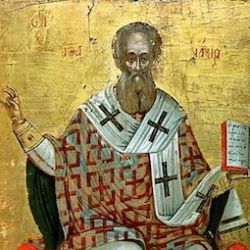- Home
- About us
- Students
- Courses
- Research
- Library
- News & Events
- Gallery
- Contact
- Our Blog
Latest News

2012 Patristic Symposium - Abstracts
 St Athanasius the Great
St Athanasius the Great
28-29th September, 2012
Convened by Very Revd Dr Doru Costache and Dr Philip Kariatlis
ABSTRACTS
Keynote Speaker
Senior Lecturer, John Paul II Institute for Marriage and Family, Melbourne (VIC)
STD (Lateran), STL (Lateran), PhD (Durham), Grad Dip Pastoral Ministry (Luther Seminary Adelaide), BTh
The Gift of Receptivity: St Athanasius on the Security of Salvation
Abstract:
Anxieties about the security of personal salvation are commonly thought to feature mostly in protestant and individualising soteriologies. In such soteriologies, security of salvation is held to be contingent upon various subjective or psychological factors such as sincerity of individual decision or persistence of personal faith. But reflection on the question of salvation's security is not without certain prominence in orthodox Christian tradition. Saint Athanasius was among a number of Fathers who sought to ascertain the conditions for securing human salvation. Given that human beings are essentially prone to defection from divine grace, and that their receptivity to God's deifying gifts is so fickle and irregular, how is the mediation of grace to human beings through Jesus Christ protected from loss? While Saint Athanasius does not overlook the role of human willing, his main answer is to locate the certainty of salvation in the bodily humanity of the Word incarnate. Since that humanity is permanently receptive to grace, so that in Christ grace is 'irrevocable' (ametameletos), all who partake in his body share in the stability of its receptivity. By appropriating our mutable physical humanity, the Word has rendered it immutable, thereby securing its freedom and making certain its capacity to attain salvation.
Mark Baddeley
Lecturer in Doctrine and Church History, Queensland Theological College
PhD candidate (Christchurch College, Oxford University), MLitt in Patristics (Oxford University), BDiv (Moore Theological College), BA in History and Classics (University of Queensland)
The Multivalent Scripture: Reflections on Athanasius' Readings of Gen 1-3 as an Example of Theological Interpretation of the Bible
Abstract:
Recently Leithart has argued that for Athanasius, “Christ is the substance of Scripture and the criterion of correct interpretation” (Peter J. Leithart Athanasius. 2011. p39). Global assessments of this kind are best calibrated by attention to examples of the actual practice of interpreting specific Scriptural texts. Accordingly, this paper will discuss several examples of Athanasius’ reading of Genesis 1-3 from various works within his corpus. In the process some of the distinctive differences and commonalities in Athanasius’ readings of the Bible will be highlighted. From this it should become apparent that one of the characteristics of Athanasius’ interpretive approach is its diversity; that Athanasius’ confidence in Scripture is reflected in the wide-ranging techniques he utilises in bringing Scripture to bear on the questions of the day. This does not overturn, but rather complements, the idea of a Christological centre in descriptions of Athanasius’ hermeneutical approach.
Associate Lecturer in Patristic Studies and Church History, St Andrew's
PhD candidate in Studies in Religion (Sydney), BTh Hons (SCD, 2010), BTh (SCD, 2009), DipBuildStud (TAFE, 2004)
Mundus Contra Athanasium: Portrait of a Saint
Abstract:
‘Athanasius against the world, and the world against Athanasius’ (Athanasius contra mundum et mundus contra Athanasium) is rather characteristic of the circumstances surrounding the saint’s life. Frequently harassed, deposed, and exiled, the bishop of Alexandria was often depicted in his immediate context – by early Byzantine historians, Church Fathers, and even emperors – as a champion of Nicene orthodoxy and a godly agent of divine providence. But this portrait of the saint has been criticised in recent times by historians manifesting a bias against the Alexandrine milieu in general. Highlighting his anti-Arian polemics, often evaluated on political rather than theological grounds, contemporary depictions of St Athanasius as both senselessly and stubbornly ‘opposed to the world’ have become commonplace. Timothy D. Barnes’ assertion that the saint must have been “conspicuously lacking in the Christian virtues of meekness and humility” (Athanasius and Constantius: Theology and Politics in the Constantinian Empire (Cambridge MA: Harvard University Press, 1994), 1), reflects this mentality. In contrast to these recent historiographical assessments, this paper will attempt to rehabilitate the traditional representations of the saint found in the works of the Byzantine historians Socrates, Sozomen, and Theodoret, in order to illustrate the remarkable life and theological landmarks which were, against all odds, achieved by him.
Senior Lecturer in Biblical Studies, St Andrew’s
DTheol (MCD, 2000), MEd (UNSW, 1986), BD (MCD, 1984), MA (BC, 1978), BA (UNE, 1973), MACE
St Athanasius and the Scriptures, Exemplified in His Letter to Marcellinus
Abstract
Although Saint Athanasius never wrote a scriptural commentary, nor explicitly drew upon Origen’s exegetical principles, all his works demonstrate his command of Scripture and its primacy in addressing specific doctrinal and pastoral questions. As has been said of him, he had ‘a biblical mind-set’ enabling him to refer spontaneously even to obscure biblical references when appropriate. The nearest he comes to a systematic “biblical commentary” is his Letter to Marcellinus on the Interpretation of the Psalms, an exploration of which will be the focus of the present paper. As might be expected, Athanasius considers, however briefly, each of the psalms, arguing that they encompass the whole of the Old Testament and, in anticipation, the central Christological focus of the New. However, what is refreshing is his classification of the psalms not according to genre, but as they reflect the diverse moods and longings of the human heart. By praying them, preferably in song, the person of faith is enabled to grow into spiritual maturity in a holistic way that is surprisingly modern.
Senior Lecturer in Theology (Patristic Studies), St Andrew's
ThD (Bucharest, 2000), BTh (Bucharest, 1993)
The Cosmos as Scripture in Clement the Alexandrian and St Athanasius the Great
Abstract:
Motivated by the fairly recent essays gathered in the first of the multi-volume work Nature and Scripture in the Abrahamic Religions (Leiden: Brill, 2008), where only a small place is reserved for St Athanasius, this paper undertakes to explore in more detail the Great Alexandrian’s diptych on creation and salvation. Thus, the two works, Against the Pagans and On the Incarnation, will be considered from the viewpoint of the Athanasian understanding of the cosmos as another Scripture that conveys the knowledge of God to those seeking it. To place St Athanasius’ understanding within its proper context, the paper will also briefly address a few relevant passages from the earlier Alexandrine teacher, Clement, whose ideas had an impact upon the saint’s views on the topic. In so doing, the paper will likewise undertake to correct the argument of Khaled Anatolios that Athanasian cosmology draws primarily on the teachings of St Irenaeus and Origen.
Rifaat Ebied
FAHA, Foundation Professor of Semitic Studies, the University of Sydney
Quotations from the Works of St Athanasius the Great in Peter of Callinicus’s Magnum Opus, Contra Damianum
Abstract:
Everybody, or at least everybody who is interested in reading about the controversy between Peter of Callinicus the ‘miaphysite’ patriarch of Antioch (581-591) and Damian (578-605) his counterpart and spiritual superior of Alexandria, will know that they fell out over the doctrine of the Trinity. Damian accused his critic (Peter) of Tritheist sympathies. Peter, in turn, put together his magnum opus: Contra Damianum in which he rebuts the thesis defended by Damian in his refutation of the Tritheists, that the characteristic properties of the divine persons, i.e. fatherhood, sonship and procession are the hypostases themselves. A critical edition of this important work was prepared by Ebied, Van Roey and Wickham and was published by Brepols in the “Corpus Christianorum: Series Graeca”, vols. 29, 32, 35 and 54 (1994-2003). In his magnum opus, Peter rebuts his opponent, Damian, by appealing to patristic proof-texts, patristic theology in order to advance his arguments and augment his thesis. To this end, he employs a large number of patristic quotations. What this work reveals is that the patristic doctrine of the Trinity inherited by Peter and Damian alike was, if not actually inconsistent, at least expressed in various and genuinely puzzling ways. The purpose of this paper is to identify, enlist and reproduce (together with an English translation and commentary) the numerous seminal quotations, in their Syriac dressing, from the various works of St Athanasius the Great, which are contained in Peter’s magnum opus.
A Short Version in Syriac and Arabic of the “Gloria in Excelsis” with Additions by St Athanasius the Great
Abstract:
The rich collection of the Mingana Syriac and Christian Arabic manuscripts, preserved in the University of Birmingham Library (England), contains numerous valuable, and in some cases unique, works. Vol. I of the Catalogue in particular contains a number of seminal works on a variety of Syriac and Arabic patristic subjects. Two of these manuscripts, Mingana Syr. MS 83 and 155, contain, inter alia, an interesting short piece in Syriac and Arabic (Garshuni) of the text of the “Gloria in Excelsis Deo” (the Greater Doxology) followed by additions by St Athanasius the Great in both languages respectively. The purpose of this paper is to present the texts of this piece as well as to provide a comparison with the Latin text of the Gloria and an English translation and comments of St Athanasius’s additions.
Daniel Fanous
Independent Researcher – Author of Taught by God: Making Sense of the Difficult Sayings of Jesus (2010), The Person of the Christ (2008).
MTh (University of Newcastle), MBBS (University of Sydney), BE (University of New South Wales)
“To Whom Was the Blood of God Offered – to Satan or to the Father?” St Athanasius on the Mystery of Atonement
Abstract:
By examining the thought of the great Alexandrine saint, Athanasius, this paper attempts to address the theme of atonement, taking as a pretext a question raised by St Gregory the Theologian. This question of what “actually” happened on the cross, in other words the nature of the atonement, is crucial to any Christian deliberation. Was the blood of Christ offered to Satan or to the Father? To whom was the ransom paid? And daringly, who indeed was responsible for Christ’s affliction? Did God punish God? This paper will seek to return to an earlier and authentically Christian understanding of redemption, and thus will categorically reject the “colourless anthropomorphisms” of penal sacrifice or satisfaction, and at once insist forcefully upon a multi-paradigmatic perception of the incarnational mystery. Specifically, this paper will argue for a self-giving participative and transformative understanding of the redemptive narrative. The key texts will be the On the Incarnation and the Letters of St Athanasius.
Silouan Fotineas
Parish Priest, St Nectarios Monastery (Adelaide)
PhD candidate (Flinders University), BTh Hons (Flinders University, 2010), BSocWk (UQ 2004), BTh (SCD 2000)
The Correspondence between St Athanasius of Alexandria and St Basil of Caesarea on the Arian Controversy
Abstract:
Saints Athanasius and Basil maintained a correspondence in support of the orthodox cause despite the imminent threat of persecution from Arian emperors. Some letters in turn were sent to churches that were struggling to survive amongst the Arians, whilst others were sent to console and sustain congregations who had their clergy forcefully removed or exiled. Still others were sent to encourage exiled bishops who were on the brink of despair. The general nature of these letters brought comfort and encouragement to the addressee. To the persecuted they reinvigorated a sense of hope for their trials and instilled in them the perseverance to continue. Whether their letters were addressed to each other, to friends or congregations, they were eventually copied and circulated amongst the faithful and proved instrumental in uniting the orthodox of the East. The following paper will endeavour to demonstrate how the correspondence between Saints Athanasius and Basil proved to be an immense catalyst to overcoming the Arian controversy.
Lecturer in Pastoral Theology and Practice, St Andrew's
Acting Level 3 Supervisor of CPE (2003), MA (Macquarie, 1980), BA (Sydney, 1964)
Why did Athanasius Take on the World? ‘Integrity’ and its Importance for Pastoral Ministry Today
Abstract
History records that Athanasius was right in refusing to water down his insistence that the Son and the Father are of one substance. But what motivated his lifelong determination to stand up to the demands for co-operation from a succession of pro-Arian Emperors and the unrelenting attacks by the Arians on his integrity? This paper looks mainly at excerpts from the writings of Athanasius himself – particularly, Against the Arians, On the Decrees, and Letters to Serapion – in an attempt to tease out the basis of his inner strength. In so doing it will highlight the importance of recovering this quality for modern day pastoral ministry.
Jonathan Douglas Hicks
PhD candidate in Theology (University of Otago), MDiv (Beeson Divinity School, Samford University, 2011), BA (Wheaton College, IL, 2005)
‘Flesh of my Flesh’: Didymus’ Trinitarian Reflections on the Creation of the Church at Golgotha
Abstract:
This paper examines Didymus the Blind’s reading of the Passion narrative in De Trinitate II.13-14 and its implications for understanding the relationship of the Holy Spirit to the Son, in an epistemological and soteriological perspective. He reads the pattern of divine activity in the latter stages of John’s Gospel as precisely analogous to the types announced in Genesis 1-3: image, rib, flesh and tree of life, thus suggesting that the creation at the end corresponds to the one in the beginning. Situating Didymus between the Trinitarian concerns of Basil and Athanasius, I argue that for Didymus the identity of the Holy Spirit is determined by his relationship to the Father with and through the Son: this relationship being revealed by a consistent pattern of divine activity. The paper aims to contribute to a growing body of literature arguing for a recovery of patristic habits of interpretation for the furtherance of ecclesial unity, doxology and theological orthodoxy.
Lecturer in Theology (Systematic)
ThD (SCD, 2010), MTh (SCD, 2001), BA (Sydney, 2000), BTh (SCD, 1995)
Soteriological Insights in St Athanasius’ On the Incarnation
Abstract
On the Incarnation is often interpreted in such a way that sees the event of Christ’s condescension as sufficient for salvation. Whilst his well-known apophthegm ‘He [the Son] became human so that we might be made God’ might easily suggest this, the work as a whole contains a rich tapestry which comprehends salvation achieved only through the entire salvific economy – namely, his Incarnation together with all the saving actions whilst on earth including his death on the cross and his incorruptible resurrection. In attempting to present St Athanasius’ multifaceted vision of salvation, the paper hopes to make a contribution on modern understandings of salvation which tend to isolate different moments.
Senior Lecturer in Religious Education, Notre Dame University
PhD candidate (Notre Dame University, Australia). MTh (JP II Institute, Melbourne, 2008), BSc (Sydney, 1987).
‘Father’ as a Divine and Human Name in St Athanasius and how his Apophatic method can illumine the Imago Dei
Abstract:
In understanding the name ‘Father’ as applied to God, St Athanasius looks at that which is being negated as much as that which is being affirmed. This is also the case for the terms Son, Word and Image. Such apophasis helps in a ‘descending’ anthropological search for an understanding of the human family as created in the image of the Trinity. Taking the method of Athanasius as a starting point and inspired by the concept of patria in Ephesians, the paper will look at attempts to nuance the concept of ‘Father’ so as to gain additional perspectives on our creation, as male and female, in the image of God.
Lecturer, School of Theology, Mission and Ministry, Laidlaw College
PhD, MDiv, MEd, LLB, BSc
Why Evangelicals Need to (More Carefully) Read Athanasius
Abstract:
With a resurgence of interest in the Church Fathers, Athanasius is generally regarded by conservative evangelicals as a hero of the faith. Even one of the “popes” of evangelicalism, John Piper, has written recently extolling the virtues and theology of Athanasius. Despite this esteem, Athanasius provides a necessary challenge to evangelicals in terms of current issues faced by the evangelical community. This challenge has hitherto not been addressed. These issues include: the importance and definition of evangelical identity; the work of Christ in relation to humanity and creation; the interpretation and authority of Scripture; the nature of salvation and the gospel; and the final destiny of unbelievers. This paper will explore how Athanasius might speak into the evangelical community with regard to these issues and suggest that Athanasius’ voice is one that needs to be heard particularly as evangelicalism faces the challenges of the cultural shift from modernity to postmodernity.
Andrew Mellas
PhD candidate in Modern Greek Studies (Sydney), LLB Hons (Sydney, 2003), BA (Hons) (Sydney, 2001)
The Eremitic Citizen as An-chora-ite in St Athanasius’ Life of St Antony
Abstract:
Revisiting St Athanasius’ seminal hagiographical text in the wake of Jacques Derrida’s interpretation of Plato’s concept of chora, this paper will explore the potential interplay between desert, demons and the abyss of chora. Plato’s Timaeusand Derrida’s On the Name will serve as points of departure in analysing Athanasian demonology and St Antony’s interaction with the landscape that becomes the topos of his withdrawal. However, in withdrawing from the world (anchorite) St Antony does not escape from it but enters its darkest recesses (an-chora-ite) where the encounter with demons becomes a metaphor for the ascetic life, the wholly other and the world inside us. I will argue that in the Athanasian rendition St Antony can be presented as someone who becomes a kind of chora tou achoretou (land of the uncontainable). Having tamed the vast array of demons, Antony’s personal transformation, which is manifested in his sublimated body, also engenders a transfiguration of the desert; the wilderness is given shape and form, it is reclaimed and shown forth as a new polis.
Ian Michie
PhD candidate in Ancient History (Macquarie), MA Th (St. Vladimir's Orthodox Theological Seminary, 2007), MA Hist (Macquarie, 2003), Grad. Dip. Ed. (ACU, 2001), BA (Sydney, 1989)
At the Beginnings of Christian Hagiography: St Athanasius of Alexandria and The Life of Antony
Abstract:
St Athanasius of Alexandria wrote an account of the life of St Antony the Great, and, in doing so, he contributed to the creation of the Christian literary genre known as hagiography. The Life of Antony rapidly became a “best seller” of the ancient world. This paper will endeavour to answer to a number of questions. Why was this book about a solitary Egyptian monk so popular in the 4th century AD, and why has it continued to capture the imagination of later readers? What spiritual, theological or political factors caused St Athanasius to set pen to papyrus? Was the Life of Antony intended to be merely an edifying biography of its subject, or was it also a polemic, written in order to defend the Nicene theological cause against the claims of the Arian heretics, and to promote the Christian monastic life? Finally, what spiritual insights can this book provide for the modern reader?
Senior Lecturer in Church History and Head of Humanities, Booth College
PhD (La Trobe), MA (Asbury), BTh (Kingsley)
John Wesley and Athanasius on salvation in the Context of the Debate over Wesley’s Debt to Eastern Orthodoxy
Abstract:
Other than John Wesley’s description of William Wilberforce in 1791 as Athanasius contra mundum and his use of the same Latin phrase in his 1775 sermon On the Trinity, there is little discussion of Athanasius on the part of the founder of Methodism. However, the Orthodox tradition to which Athanasius is so central a figure had an important shaping influence on Wesley’s theology and there are strong soteriological resonances between Athanasius and Wesley, some of which will be elucidated in this paper. The Methodist ecumenist Albert C. Outler was one of the first, in the 1960s, to alert modern Wesleyans to the need to examine closely their founder’s heavy indebtedness to the Ante-Nicene and Nicene Fathers, especially in his doctrine of Christian perfection. More recently, Kenneth J. Collins has disputed the strong connection between Wesley’s theology and Orthodox theology and has argued that those who accept Outler’s argument have overlooked the significance for Wesley of his own Anglican tradition, in particular the ‘holy living’ tradition of William Law and Jeremy Taylor. This article will survey recent discussion of this issue among Wesley scholars, caution against too great a dogmatism on the question, and argue that Wesley’s practical theology was essentially eclectic.
Associate Lecturer in Theology (Patristic Studies), St Andrew's
PhD candidate in Studies in Religion (Sydney), MTh Hons (SCD 2008), MTh (SCD 2002), BTh (SCD 2001)
Features of the Theandric Unity of Christ in St Athanasius’ Letter to Epictetus
Abstract:
St Athanasius’ letter to Epictetus constitutes one of the most significant sources of Patristic Christology. The importance of this letter is witnessed by the fact that the Christological insight embedded within was appropriated by St Cyril of Alexandria in his own Christological elaborations, and was subsequently used as an authoritative text at the Third Ecumenical Council in 431 at Ephesus. This paper will explore features of the Christology of St Athanasius as expressed in the Letter to Epictetus maintaining that it contributed towards an important articulation of the theandric unity of the person of Jesus Christ.
Dean and CEO of the Sydney College of Divinity; Honorary Associate Department of English, University of Sydney
PhD (London, 1970), MTh Hons (Sydney, 1999), MA Hons (Sydney, 1968), BA Hons (Sydney, 1965)
St Athanasius’s Life of St Anthony and Hagiographical Tradition
Abstract
Athanasius’s Life of St Anthony is renowned as a seminal text in the history of hagiography. The Life itself comes very early in the history of records of saintly heroes of the church and has been reproduced down the centuries in a range of literary contexts, including the ubiquitous medieval compilations The Lives of the Fathers (Vitae Patrum) and the Golden Legend(Legenda Aurea), themselves key points for dissemination of information about and appreciation of St Anthony. Beyond this, however, the Life of St Anthony is acknowledged as a key textual model for much subsequent hagiographical writing, from that of Athanasius’s younger contemporary St Jerome and on into the medieval period, when hagiographical patterns became, arguably, fixed firmly. This paper addresses the textual nature of the Life in relation to its own textual sources and its textual influence on the development of the great hagiographical tradition of the church, with particular reference to the Bible, on the one hand, and the great medieval texts referred to above, on the other, to offer a fresh taxonomy of the hagiographical features that make this Life the text it is.
 Adam G. Cooper
Adam G. Cooper
.jpg)





.png)